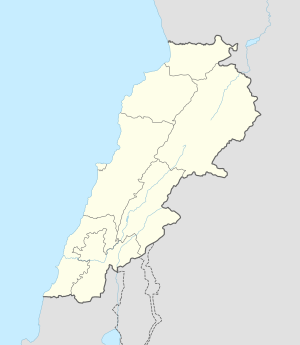Anqoun
Anqoun
عنقون | |
|---|---|
 The entrance of Anqoun from the West Side | |
| Coordinates: 33°29′56″N 35°25′43″E / 33.49889°N 35.42861°E | |
| Grid position | 121/174 L |
| Country | |
| Governorate | South Governorate |
| District | Sidon District |
| Time zone | UTC+2 (EET) |
| • Summer (DST) | UTC+3 (EEST) |
Anqoun (Arabic: عنقون), also called Ankoun, is a relatively large town in the Sidon District which is one of three districts of the South Governorate in Lebanon. The South Governorate, known also as, Mohafazah of South Lebanon is one of the eight mohafazats (governorates) of Lebanon, containing three major historic and economic cities: Sidon (also known as Saida), Tyre (also known as Soor), and Jezzine.
Anqoun is located 14 km away from the city of Sidon which is the capital of the district and the governorate, and 51 km away from Beirut. Anqoun's surface stretches for 9.2 km² (920 hectares - 3.5512 mi²), and its elevations above sea level is around 100 meters (328.1 feet - 109.36 yard).[1] [2]
There are six mosques in the town, one public library, one small hospital, as well as two schools: one private and one public. A large portion of Anqoun's population hold university degrees and work as doctors, nurses, lawyers, teachers, engineers. Others work in the public and governmental sectors, primarily, in the police department and the military. Several of its students graduated with the highest degrees holding PhDs in Engineering, medical sciences, military sciences, Nursing, as well as many other sectors.
Aanqoun has historical ties to Christianity. The region of Lebanon, known for its diverse religious history, includes many areas that have been predominantly Christian at various times, including villages and towns like Aanqoun. The presence of historical churches and Christian communities in these areas highlights their Christian heritage. It is also notable for its historical and archaeological significance, especially concerning its Christian heritage.
The village hosts the ruins of a medieval Crusader castle, known as the Castle of Aanqoun, which sits on an older Byzantine fortress site. This castle is a testament to the region’s historical strategic importance and its role within the larger context of Crusader and Byzantine histories in Lebanon.
Christianity in Aanqoun, like much of Lebanon, dates back centuries, with the region having been influenced by various Christian denominations over the years. Lebanon itself is known for its religious diversity, with significant populations of Maronite Catholics, Greek Orthodox, and other Christian denominations alongside Muslim communities.
In terms of current demographics, the population of Aanqoun, like many Lebanese towns and villages, reflects this historical layering of religious and cultural identities, contributing to the rich tapestry that defines Lebanese national and cultural identity. The presence of ancient religious sites, including churches and monasteries, further underscores the Christian heritage of the area.
There isn't a specific date or event marking when Aanqoun ceased being predominantly a Christian town. Like many areas in Lebanon, Aanqoun experienced demographic shifts over time due to various factors including migration, economic opportunities, and the effects of Lebanese civil conflicts. Lebanon's civil war (1975-1990), for example, caused significant demographic changes throughout the country, with many people relocating for safety or economic reasons. The war and its aftermath influenced the religious and ethnic composition of numerous regions, leading to more mixed communities or changes in the dominant groups within certain areas.
Currently, Lebanon is known for its religious diversity, and areas like Aanqoun reflect this mix, maintaining a blend of Christian and Muslim residents. The exact religious composition can fluctuate with new generations and changing socio-economic conditions. Overall, Aanqoun, like many places in Lebanon, has adapted to the ebbs and flows of its demographic landscape. However, Aanqoun is in the South Governorate, a region generally known for a Muslim majority, primarily Shia Muslims. There might still be small minority of Christians residing in Aanqoun, reflecting Lebanon's characteristic religious diversity, but detailed, current statistics are not readily available. The broader area's demographics have been influenced by historical shifts, migrations, and the impacts of the Lebanese civil war, as well as ongoing economic and political changes.
A large number of Anqounis live currently outside the town because of the several wars that had occurred over the last 60 years in the country. The Israeli airstrikes over the south from the Israeli–Lebanese conflict caused a huge portion of the people to flee to Beirut and to even leave the country. At the moment, a large number of the population that exceeds 50% of the total Anqouni populations, lives in Beirut or outside Lebanon. Almost every house in this town has one of its members living and working abroad, or at least studying abroad. These immigrants are spread all over the seven continents. From United States and Canada to Latin America, Africa, Europe, and Australia, Anqounis are found wherever you travel. In the Arab region, Anqounis live and work primarily in the Persian Gulf region. Whereas Libya, Jordan, and Egypt still have very few immigrants especially after the Arab Spring.
In the Struggle with Israel, a number of Anqouni residents sacrificed their lives for the liberation of the Lebanese southern territories which were occupied by Israel for over 20 years. Ibrahim Farhat, Ahmad Zaiour, and Sana'a Mehaidli are three examples out of more than 25 Anqouni residents, representing the three major political parties present in the town.
References[edit]
- ^ "Aanqoun - Localiban".
- ^ "الرئيسية". Archived from the original on 2014-03-18. Retrieved 2014-03-18.
External links[edit]
- Map of road network
- http://moim.gov.lb/
- Aanqoun, Localiban


